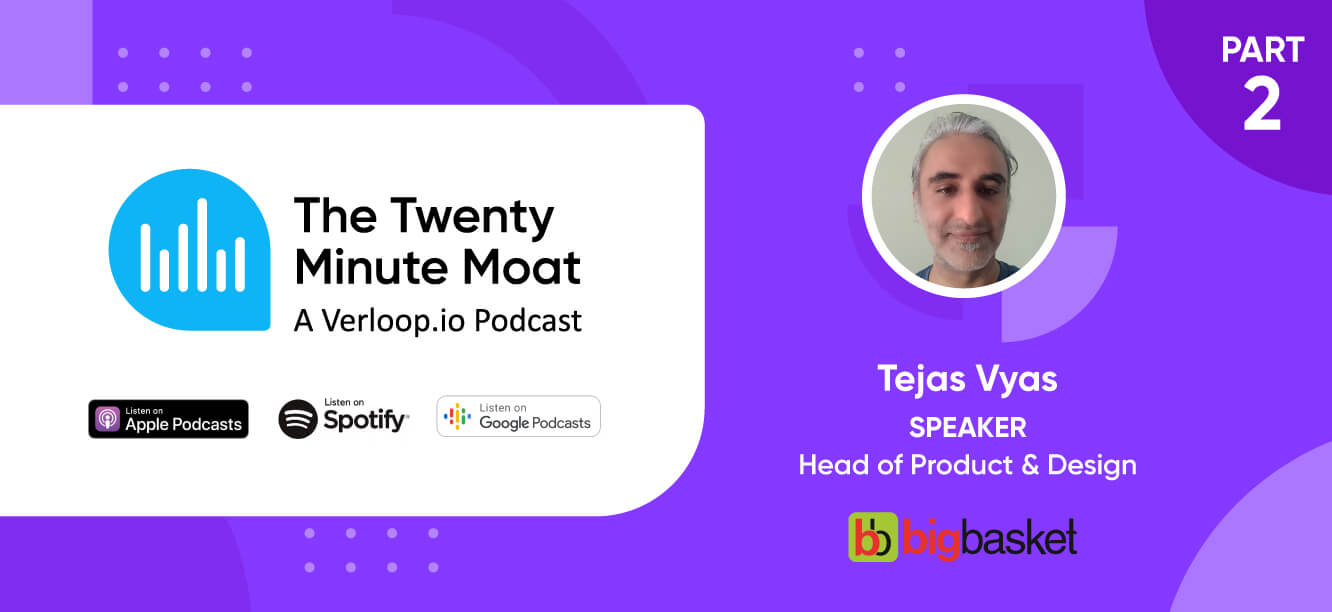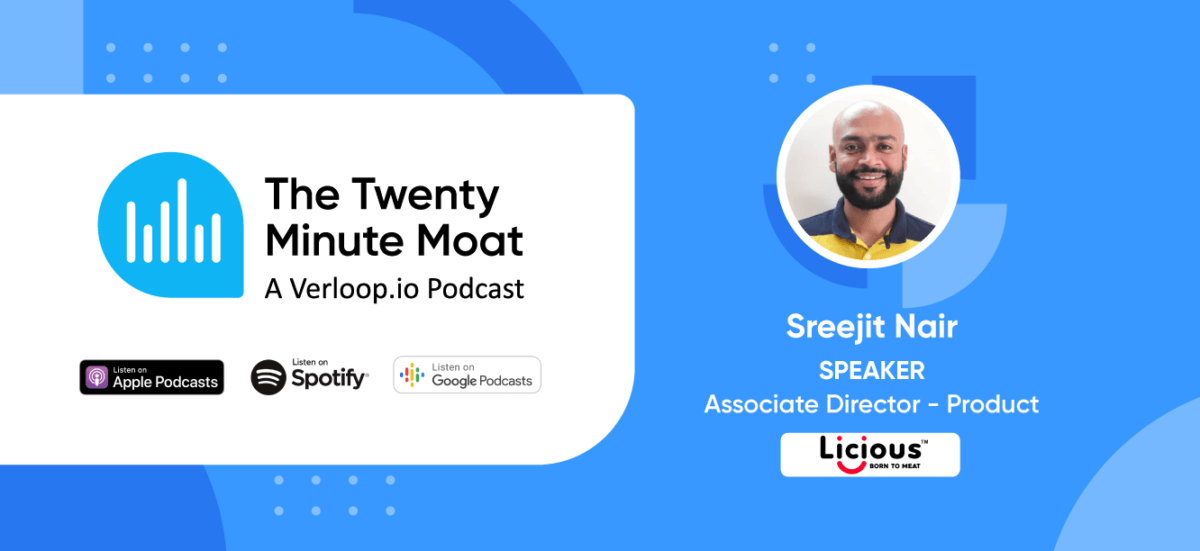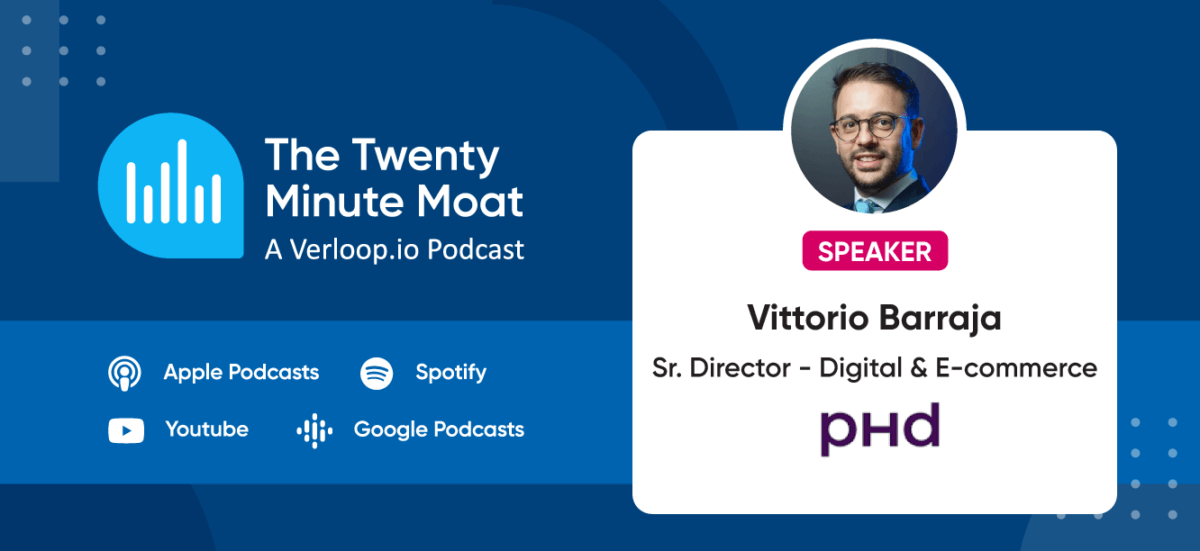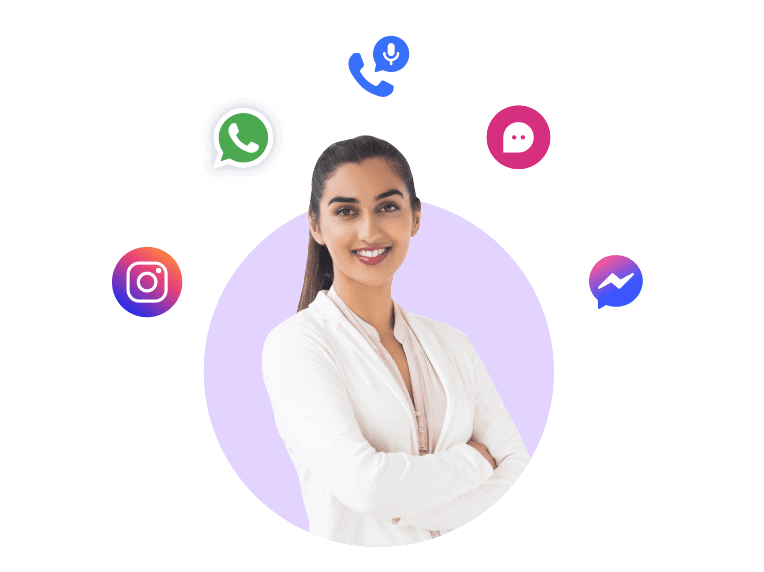Duration 21:06
Guest Speaker

Akshat Saxena
Co-founder - ePayLater
Industry
Fintech
Akshat Saxena is the Co-founder of ePayLater, the platform that has scaled to become one of India’s largest in the SME credit space. ePayLater has partnered with retail majors such as Wal-Mart and Metro AG, and was awarded as “Most Innovative FinTech” by Govt of India in 2019. Akshat Saxena has been recognised as the “Achiever of the Year 2017” by BusinessWorld, and is a part of the FinTech advisory committee of FICCI – an apex body for providing policy inputs to the Govt.
We cover:
- How customer support works at ePayLater?
- How to build trust with customers in Fintech?
- Why customer support needs to be omnichannel?
Podcast Transcript
In this customer trust building podcast, we have Akshat Saxena as our podcast guest and Jude Gerald Lopez as our podcast host.
Jude Gerald Lopez
Welcome to another episode of the 20 minute moat podcast.
On this episode, I’ve got Akshat Saxena who is the co-founder for ePayLater, one of the biggest brands right now in Fintech and who’s working in the SME credit space in India. So welcome to the show Akshat.
Akshat Saxena
Hey, thank you so much Jude. It’s a pleasure to be here.
[00:33] Jude Gerald Lopez
You know I can give our viewers a little brief on your introduction, but I think it’ll be more poignant if you are gonna give them a brief of your role and your journey with your company, ePayLater.
Akshat Saxena
Sure. So, first of all, a big hello to all your viewers. And I am Akshat Saxena. I am the, I am one of the three co-founders here at ePayLater.
And, about me, so I have, I mean, ePayLater is 6 years old, so I’m as old as ePayLater within ePayLater.
And, prior to ePayLater, I worked in corporate world for about 8 years with technology firms such as Oracle, SAP, and Trans Union.
And, outside ePayLater, I am a tech enthusiast. I mean, I was ranked world number one by a technology website called Hacker rank a couple of years back.
And, I, I am also part of a, you know, a, a think tank which works, you know, it basically does some research work and provides some policy inputs to, to, to the policymakers here in India.
And I’m also a visiting faculty to one of the B-schools here, one of the IIM’s here in India.
And I’m based out of Gurgaon, a satellite town of Delhi, the capital of India, and I live here with my wife and my 1 1/2 year old daughter. So that’s, that’s my little introduction.
[02:12] Jude Gerald Lopez
Ah, that’s lovely to hear Akshit, you know, we’ll, jump right into the conversation.
You know I wanted to ask, quite a bit I know from you first hand, you know, what exactly is the customer experience space like, particularly with the fintech brand like ePayLater.
So, one thing that I wanted to start off with was, you know, in traditional finance or institutions in the traditional space, customer service and customer experience sometimes takes a backseat.
With Fintech, and a lot of new startups and lot of new organisations coming up in this space, this has been a key area of focus, where, how do we completely overhauled the way customers are catered to.
And, I just wanted to know, at ePayLater, what is customer experience and customer service like?
Akshat Saxena talks about customer service and experience
So for us, I mean, I mean, customer experience is, is a center stage of everything that we do. You know, we, we, I mean, and I mean, I will possibly take, you know, you know, a step back and tell you what, what we do, you know, possibly in the interests of those viewers who might not know about our business.
So we extend a credit line to small businesses. So there are, there are about 65 million MSME in India and the credit penetration of, the formal credit penetration India is, is quite low.
So we have identified a few industry verticals such as food and groceries, pharma, wherein we have a, these are our focus verticals and we extend credit lines to, you know, the small businesses who then use that credit line for making purchases from their suppliers.
And our offering is that, you know, within just five minutes, no matter where they are in India, they can, by just making a few simple clicks on our application, they can get a credit line up to 2.5 million Indian rupees, right?
So it’s a big shift from the, the, the way, you know, traditional credit, you know, operates, where in, the approval rates are low, it’s very documentation heavy, it takes time, and stuff.
So that’s what we do. Right, so now with that as a context, to answer your question, for us, you know, we, we connect, we are a digital-first company, right?
So, for us, connecting with our customers, over a digital interface completely changes the way, you know, we define customer experience for ourselves.
We try and keep our customer interfaces absolutely clean and we, and absolutely intuitive. That’s one part of our customer experience.
We also try and ensure that every interaction of the customer with us across any of our channels, while it’s predominantly, digital but customers also reach out to us through other channels as well.
So every interaction is, is meaningful and we try and, you know, package all the information that the customer is seeking in the simplest possible way, and the quickest possible with.
Our customers being business customers, they appreciate the fact that we value their time. And they also appreciate the fact that we are giving them information in a very palatable manner.
So that’s, you know, one of the most essential ingredients of our, one of our, customer experience at our end.
The other thing that we try and do is, you know is, is to, you know, impart confidence in our customers. The confidence that we are here anytime of the day, any day of the week.
And we are here to hear, hear them and we are here to, sort of, try and, we’ll be happy to, you know, travel an extra mile to support them.
These are, these are, uh, as you would appreciate, these are customers who have, you know, not been the, you know, the, the, the customers who have not been pampered by the traditional financial institutions, right?
And they, for them, therefore, the way they perceive a, you know, the banking system is, is very different, right?
So, so we are trying to create a red carpet experience for the customers who have been not so focused upon, or, or neglected by the traditional banking system.
And trying to basically, therefore be their, their, their partner in their growth journey, yeah. And, and our entire customer experience, our communication, all interactions are centered around that.
[06:37] Jude Gerald Lopez
I think that red carpet experience for these smaller players in the industry and, you know, SME’s particularly, I think that’s a very, very important point because, on the one hand you’re also creating, you are giving access to finance.
You’re making access to financial credit, and all of these things a lot easier.
I had this one question, you know, like since we’re talking about Fintech and since we’re talking about credit and all these things, trust plays a huge part.
Akshat Saxena
Yes.
[07:05] Jude Gerald Lopez
So how do you, you know, how do you create that element of trust and is there something that you look at when you are creating a kind of a CX strategy?
Akshat Saxena talks about strategies in building customer experience
So, see creating trust I, I feel there are no shortcuts to it. It’s about, you know, defining a value system and ensuring that everybody in the organization understands it well and living that value system day in day out, you know, iteratively.
You know, being absolutely honest about what you can or what you cannot do to the customer is just one hygiene condition, and I think, frankly speaking, you know, that’s one area where in we have, at least our experience has told us that, you know, we haven’t, uh, or the industry hasn’t done very well.
I mean, most of these customers, they have been either underserved or they have been, I mean, they, the guys have been overpromised, right? Now, that’s something which we try to stay clear from.
You know, we have tried to tell them, you know, that this is what we can deliver to you, this is the value for you, and this is how our processes, policies work.
And we have also tried to, you know, understand their challenges, even if that’s something that we cannot address at this point of time.
So we have tried to create an owner of our product or, for that matter, even our company strategy, in a way, where in, you know, we are, we work, we work backwards from our customers expectations from us, right?
And that has helped us build trust, right?
When, when the, when the customers realise that we are not here just to help address their existing set of challenges, but also, you know, we are working in the background towards solving challenges that you know, that, that, you know, they ,they, currently not solving, you know.
It, it generates that confidence and that trust is them.
And since we have been at it for so many years, frankly, some good word has spread about us.
I think it creates a sort of a vicious loop, sorry, a virtuous loop wherein, you know, there are positive influencers on the ground, and I think that positive peer feedback does a lot of magic, right?
And then, that, uh, trust is now sort of multiplying and, you know, it’s, it’s, it’,s it’s what it is, is helping us scale fast.
[09:45] Jude Gerald Lopez
Interesting. That’s quite insightful, but I, I had a kind of a follow-up question. So, we we are talking about like, you know, the difference in terms of, you know, the experience a customer gets when he’s interacting with the brand, like ePayLater, in opposition to, say a regular bank.
So, is there anything specific that you can, like, you know, point and say, this is how we differ? Like, it could be in terms of how quick the process is, or how transparent the process is, or, if there is, like, you know, some kind of ease of access features that, you know, customers can get with a brand like ePayLater. A few of those anecdotes I think would be really, really powerful.
Akshat Saxena talks about the implementation
Yeah. So, you know, there’s some, basics or on, on, on, you know, what we do. See, credit is, is not the end product right?
And that’s true for any credit product as such, right? I mean end product is, is a house in case of a home loan, or it’s, it’s a car in case of car loan right?
In our case, it’s, it’s, it’s the stock, right, that, that, that, a businesses buying from a supplier, right?
So what we have tried to do is to appreciate that fact that, you know, we, we are not an end product company, but we need to help our customers consume the credit in a way that it helps them achieve that end goal.
So we have tried to create more optionality for the customer wherein they can use the credit line across various partners.
We have also, then went a step ahead and we’ve tried to discover more potential suppliers for them, wherein they can not just utilize the credit on the partners that are currently there in the picture, but also, you know, we can help them enlarge that canvas, right?
So that’s something which has really helped us become their, you know, partner for growth, and also helped us scale fast, right?
Other thing is that, you know, we have also tried to create these little product interventions that, that you know, help us generate a better customer experience and a more engaging experience with the customers, right?
So what we, you know, have allowed to the customers to do is to, you know, they can now also onboard any supplier that they discover. And the good thing that, you know, has happened is that the customers are becoming more comfortable with digital interfaces, right?
I mean these are, these are small businesses, you know, but they are very high on their awareness of digital technologies.
They are very comfortable browsing for potential supplier, potential suppliers on the Internet and stuff.
Now when that happens, right, here is a, there’s small business trying to, you know, make a purchase from a supplier where there is no vintage of relationship, right?
And therefore, there is an inherent trust deficit on both sides, right?
The supplier would want payment first, the buyer, business buyer, who’s our credit user, would want a shipment first right?
And that’s exactly where we fit. If you look at, I mean again, the tech, credit literally stands for trust, right?
So we basically try and help bridge this trust gap. We are telling the supplier that don’t worry about payment, ePayLater will assure it.
We are telling the buyer that don’t worry about shipment. You have no payment obligation until you actually physically receive the shipment, then OK.
And by bridging this trust deficit it, it, it, basically, you know, generates a lot of opportunities. The B2B commerce, which, last mile B2B commerce, which is largely hyperlocal, suddenly become boundaryless.
Here is a small little kirana shop in Agra, one part of the country, and now they can make purchase from, let’s say, a potential supplier in, in Gujarat, you know, probably get a better deal higher margin and stuff, right?
So this is, therefore a credit solution goes much beyond a financial solution. It becomes literally a solution that solves for trust and customers really see value in, in, in the fact that they are now able to generate higher margins and more, they are able to, you know, create more optionality on the supply side.
And, I mean, again, to my earlier point, this, this creates that, that virtuous loop.
[14:15] Jude Gerald Lopez
Interesting. I’m gonna like, go on the same tangent here and just dive deep into customer support as, you know, an operations thing.
So, do, do you have this issue of seeing customers reach out to you on multiple channels, or is it, you know, through one particular means?
Is it like just through telephone, or is it email, or is there automated processes involved and how have they been reacting to that?
Akshat Saxena
It’s a very interesting question. Frankly, you know, it’s been evolving, So, four years back, when we hit the market, the customers were more comfortable meeting us in person.
So we would have our sales teams going out in the market, meeting them one on one and, and, you know, it, there wouldn’t be a life outside of that in person interactions, right?
I mean so, but over a period that has changed. The customers have become more comfortable, and I think we have also become conversant with the interface that we provide to them to connect with us.
So as we speak, depending upon the use case, so here is a customer who is, you know, in an exploratory mode.
These customers would typically, you know, visit our website or they will download our app and, and stuff.
And, you know, if they have any questions, they will write to us on the social media, or, or they will sometimes send us an email. So that’s, that’s general.
In, in case there is any customer service query, right, now then it, it, it, it usually is, is a, is a human call that, that, that, you know, which, which customer makes and expects a, you know, a human response on the other side, right?
So that’s, or in, in cases where in, you know, it’s a large customer, you know, they, they also at times expect a person to show up and, you know, discuss certain things with them and stuff.
So we also have our own ground teams. That’s, that’s another channel.
What we have also done is we’ve created a, you know, a, a chat based channel. We’ve also, you know, created a few other channels.
And, to our own surprise, I mean, these customers are very, very comfortable using those channels.
So in a nutshell, it’s, it’s a, a lot of channels right now, a pretty much omni channel and depending upon, you know, what is the use case, there is a higher concentration of a particular channel.
[16:47] Jude Gerald Lopez
Ok. I think omni channel is one, and the other side of that coin is multilingual support. So do you see, I mean, is that, has it been a challenge, in customer support where you’re dealing with, you, know the length and breadth of the country, people speaking in different different languages?
Or do you see your customer base all able to converse in English or another common language?
Akshat Saxena
No. So, see in our kind of business, we’re dealing with small businesses. Frankly, again, as a part of generating more confidence and trust, if we can talk their language, and, you know, not, and you know, and also use their lingo, I mean it, it basically invokes more confidence.
So for us it’s been multilingual support that we’ve always believed in and frankly, a lot of customers are are, are, are, you know, not even very comfortable in, in language other than, you know, the national language or their local language, right?
So while we do support English, I mean, it hasn’t been the only language that we have supported, it’s already multilingual.
[17:55] Jude Gerald Lopez
I think while that’s a, that can be a challenge, I think that’s also a huge opportunity because when the customer realises that, you know, you are, even if it’s a, if it’s an automated or a human person talking, if they are conversing in the language that they’re comfortable with, that really, really creates a lot of emotional value for that interaction.
So I think that would be a very very delightful customer experience from their point of view.
I mean, it’s been an interesting conversation. Before I let you go Akshat, one more question. Where do you see customer support heading in the next few years?
More automated processes, but how do you, how do you see this industry evolving?
Akshat Saxena
So, the way I look at it is that, you know, there are a lot of customers who like to help themselves, right? And, you know, if you provide them sufficient tools and, you know, as long as you have been able to generate enough confidence and trust in your customers, they’re comfortable using self-help tools.
In fact, we have seen that, as customer vintage increases in the system, they are more comfortable using this self-help tools even when they have an option of reaching out to a call center and stuff.
And we, we, we feel that, you know, the reasons of the, this is like quite, quite, quite straightforward.
I mean, these customers, they interact with those self-help tools because those are like real time and, you know, it addresses their query.
However, you know, what we have, what, where I, what I feel is that, on matters wherein there, you know, wherein there is an element of, of, let’s say, financial risk involved, I, I think there, the human interface would continue to sort of remain relevant for, for, you know, times to come in the foreseeable future, especially when you are talking about a large, you know, sized B2B transaction, which is, which is what we see in our case, right?
Here is a customer who is, so, you know, suddenly wanting to make a large transaction, out of blue or something.
I mean, then, then, you know, they, they like to have someone reassure them, either in person or over a call that all is good and we will take care of, you know, their transaction and everything is fine.
So I feel, you know, that’s how the customer service is gonna evolve over a period of time.
There are going to be more self serve tools, more chat bots, right, more relevant FAQ, or hopefully something where in the customers can easily look up and, and, and help themselves.
But at the same time, you know, where it’s a high involvement purchase, I, I think a human interface is, cannot be substituted.
Jude Gerald Lopez
Brilliant, I think, I think we have covered quite a lot of very interesting topics. Right from trust to multilingual support to self service. I think it’s been an absolute delight talking to you Akshat, and I think our viewers also will find this conversation extremely insightful.
So thank you so much. Thank you for taking the time out to be on the 20 minute moat podcast. I loved this conversation and I’m sure everyone listening in is also enjoying this conversation, so thank you.
Akshat Saxena
Thank you so much Jude for the opportunity. It was a pleasure talking to you.



